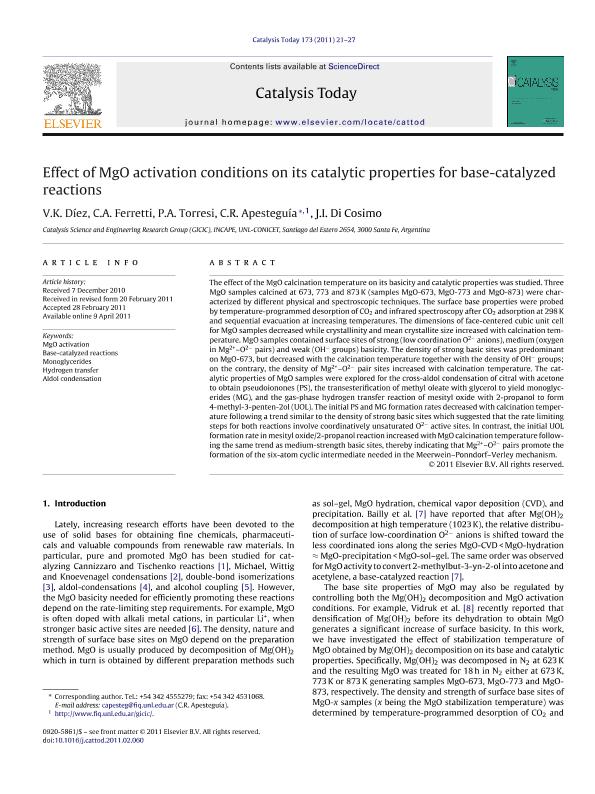Artículo
Effect of MgO activation conditions on its catalytic properties for base-catalyzed reactions
Diez, Veronica Karina ; Ferretti, Cristián Alejandro
; Ferretti, Cristián Alejandro ; Torresi, Pablo Antonio
; Torresi, Pablo Antonio ; Apesteguia, Carlos Rodolfo
; Apesteguia, Carlos Rodolfo ; Di Cosimo, Juana Isabel
; Di Cosimo, Juana Isabel
 ; Ferretti, Cristián Alejandro
; Ferretti, Cristián Alejandro ; Torresi, Pablo Antonio
; Torresi, Pablo Antonio ; Apesteguia, Carlos Rodolfo
; Apesteguia, Carlos Rodolfo ; Di Cosimo, Juana Isabel
; Di Cosimo, Juana Isabel
Fecha de publicación:
09/2011
Editorial:
Elsevier Science
Revista:
Catalysis Today
ISSN:
0920-5861
Idioma:
Inglés
Tipo de recurso:
Artículo publicado
Clasificación temática:
Resumen
The effect of the MgO calcination temperature on its basicity and catalytic properties was studied. Three MgO samples calcined at 673, 773 and 873 K (samples MgO-673, MgO-773 and MgO-873) were characterized by different physical and spectroscopic techniques. The surface base properties were probed by temperature-programmed desorption of CO2 and infrared spectroscopy after CO2 adsorption at 298 K and sequential evacuation at increasing temperatures. The dimensions of face-centered cubic unit cell for MgO samples decreased while crystallinity and mean crystallite size increased with calcination temperature. MgO samples contained surface sites of strong (low coordination O2- anions), medium (oxygen in Mg2+-O 2- pairs) and weak (OH- groups) basicity. The density of strong basic sites was predominant on MgO-673, but decreased with the calcination temperature together with the density of OH- groups; on the contrary, the density of Mg2+-O2- pair sites increased with calcination temperature. The catalytic properties of MgO samples were explored for the cross-aldol condensation of citral with acetone to obtain pseudoionones (PS), the transesterification of methyl oleate with glycerol to yield monoglycerides (MG), and the gas-phase hydrogen transfer reaction of mesityl oxide with 2-propanol to form 4-methyl-3-penten-2ol (UOL). The initial PS and MG formation rates decreased with calcination temperature following a trend similar to the density of strong basic sites which suggested that the rate limiting steps for both reactions involve coordinatively unsaturated O 2- active sites. In contrast, the initial UOL formation rate in mesityl oxide/2-propanol reaction increased with MgO calcination temperature following the same trend as medium-strength basic sites, thereby indicating that Mg2+-O2- pairs promote the formation of the six-atom cyclic intermediate needed in the Meerwein-Ponndorf-Verley mechanism.
Archivos asociados
Licencia
Identificadores
Colecciones
Articulos(INCAPE)
Articulos de INST.DE INVEST.EN CATALISIS Y PETROQUIMICA "ING. JOSE MIGUEL PARERA"
Articulos de INST.DE INVEST.EN CATALISIS Y PETROQUIMICA "ING. JOSE MIGUEL PARERA"
Citación
Diez, Veronica Karina; Ferretti, Cristián Alejandro; Torresi, Pablo Antonio; Apesteguia, Carlos Rodolfo; Di Cosimo, Juana Isabel; Effect of MgO activation conditions on its catalytic properties for base-catalyzed reactions; Elsevier Science; Catalysis Today; 173; 1; 9-2011; 21-27
Compartir
Altmétricas



